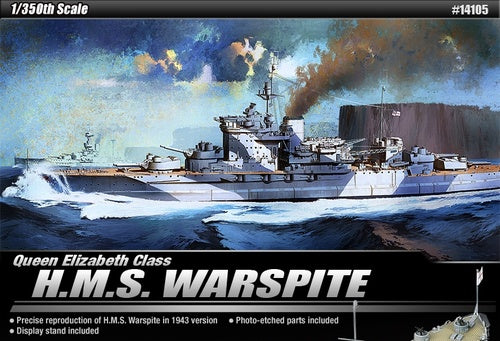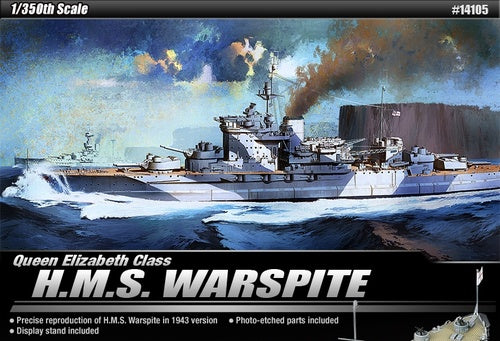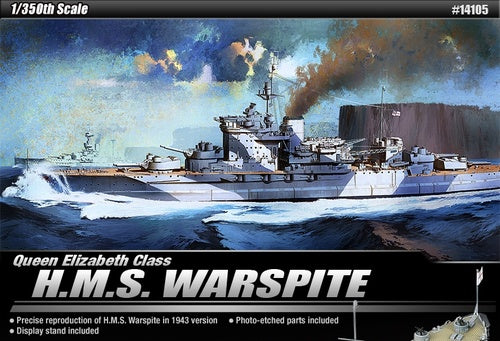Academy 1:350 HMS Warspite Queen Elizabeth Class
Academy 1:350 HMS Warspite Queen Elizabeth Class is backordered and will ship as soon as it is back in stock.
Couldn't load pickup availability
Delivery and Shipping
Delivery and Shipping
We use tracked courier for fast delivery New Zealand wide
Description
Description
HMS Warspite was a British battleship laid down in 1912, launched in November 1913, and commissioned in the Royal Navy in March 1915. The total length of the ship was 195 m, width 27.6 m, and full displacement - 33,400 tons. The maximum speed of battleship Warspite was around 25 knots. The main armament at the time of the launch was eight 381 mm guns in four twin turrets. The secondary armament consists of 12 152mm guns, 2 76mm guns, 4 47mm pom-poms, and 4 533mm torpedo tubes.
HMS Warspite was one of five Queen Elizabeth-class battleships. Battleships of this type were built just before the outbreak of World War I, as a British response to the rapid naval armament of the Second German Reich. They are often referred to as super-dreadnoughts - for the first time in the history of the navy, 381 mm artillery with 42-caliber barrels was used on them, and for the first time battleships reached a speed of about 25 knots. Many of the solutions used on this type were reflected in later British battleships. All ships of the Queen Elizabeth class also underwent significant modifications in the interwar period: first of all, they received new engine rooms, better and more efficient boilers, their armor was thickened, the profile of superstructures was changed and the anti-aircraft artillery was significantly expanded. Thanks to these upgrades, these ships were not inferior to other German or Italian battleships, as well as many Japanese battleships - with the exception of the Yamato class. The HMS Warspite battleship was built at the Dockyard shipyard in Devonport. From the moment he entered service, he was part of the Grand Fleet and, as part of it, took part in the Battle of Jutland in 1916, in which he did not suffer any serious damage. For the rest of World War I, he did not enter into any serious combat contact with German ships. However, he took part in the internment of German units in Scapa Flow. In the interwar period, it served both in the Atlantic Ocean and in the Mediterranean Sea. His glorious and rich combat route during World War II began with the struggle at Narvik in April 1940, contributing significantly to the Allied success in the so-called II Naval Battle of Narvik on April 13, 1940. Shortly thereafter, he was transferred to the Mediterranean Sea where he took part in the Battle of Cape Matapan (March 1941). In the second half of 1941, he was sent to the USA for modernization, which lasted until the end of that year. In early 1942, it found its way to the Indian Ocean, but later returned to the Mediterranean Sea - shortly before the invasion of Sicily in July 1943. In September of that year, it supported the Allied landing at Salerno, where it suffered severe damage. After the renovation, it supported the Allied forces landing in Normandy in June 1944 with their artillery fire. The last time he took part in the action was November 1944. After the war, in July 1946, it was scrapped.
Payment & Security
Payment methods
Your payment information is processed securely. We do not store credit card details nor have access to your credit card information.




